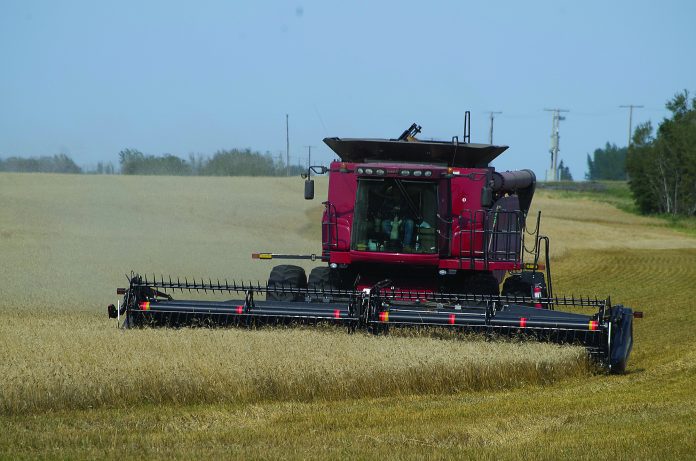
Ministry of Agriculture, Submitted
Producers are in the full swing of harvest with 33 per cent of the crop off, up from 21 per cent last week and ahead of the five-year average of 23 per cent and the 10-year average of 20 per cent.
The southwest has crossed the half-way point this week and is now 60 per cent complete harvest. The west-central is close to the half-way point, with 39 per cent of crop off for the year. With some moisture moving into the area this week, the northwest had to pause combining for a few days and is now eight per cent complete.
All crop types are starting to reach maturity in the province, allowing producers to make progress in all crops this week. Fall cereals are nearing completion, with 96 per cent of fall rye and 89 per cent of winter wheat in the bin for the year. Lentils and field peas are leading the way in spring seeded crops, with 80 per cent of each crop harvested. Mustard made significant progress this week, with 55 per cent of the crop harvested, ahead of other oilseeds including canola (10 per cent) and flax (seven per cent). Producers are currently focusing on getting their spring cereals harvested and have 48 per cent of durum, 46 per cent of barley, 26 per cent of spring wheat and 19 per cent of oats harvested. Sixty per cent of triticale is harvested, with 56 per cent being used for feed.
The east side of the province generally received moisture this week, with the Bankend area receiving 50 mm and the Tisdale area receiving 34 mm. Cropland topsoil moisture ratings are improving as recent rains seep into the ground. Currently, cropland is 32 per cent adequate for moisture, 43 per cent short and 24 per cent very short. Hay and pasture land is 22 per cent adequate for moisture, 49 per cent short and 29 per cent very short.
Crop damage this week includes environmental damage such as hail, wind, drought and localized flooding. Damage from grasshoppers and gophers continues to persist. Geese have returned to the northern fields and are causing damage to crops. Producers are busy combining, desiccating and marketing grain. Others are marketing cattle, hauling water and feed. Some producers have started to move cattle home for the winter. If producers have questions about feed, they are encouraged to call their local regional specialist.
Harvest is a very busy and stressful time for producers. They are reminded to take safety precautions in all the work they do. This includes having fire mitigation resources at the ready and taking precautions when working around powerlines. The Farm Stress Line is available to provide support to producers toll free at 1-800-667-4442.
The public is reminded to take extra caution, time and space when encountering machinery on the roads.
Northeastern Saskatchewan
The northeast region now has 13 per cent of this year’s harvest completed, slightly ahead of the five-year average of 12 per cent. Producers have been able to make the most of a few days without moisture in the region.
With the fall cereals harvested for the year, producers are making headway in their field peas at 58 per cent harvested and lentils are virtually complete. Spring cereals are the primary focus of harvest in the region right now, with 44 per cent of durum, 36 per cent of barley, 15 per cent of spring wheat and nine per cent of oats harvested. Minimal harvest progress has been made in oilseed crops.
A few scattered showers moved through the northeast this week, with the Tisdale area reporting 34 mm. An increase in topsoil moisture was reported this week, with three per cent of crop land having a surplus of topsoil moisture, 77 per cent is adequate, 19 per cent is short and two per cent is very short. Five per cent of hay and pastures have a surplus of moisture, 67 per cent is adequate, 27 per cent is short and one per cent is very short.
Crop damage this past week is mostly due to wind and drought damage, with some localized flooding. Producers are busy desiccating and combining crops, while working livestock and hauling bales.
Northwestern Saskatchewan
Harvest is eight per cent complete in the region, which is just below the five-year average of nine per cent. Producers are wrapping up desiccating as harvest is entering full swing.
Producers have shifted their focus from fall rye, which is 94 per cent harvested, to their spring seeded crops this week. Field peas are 56 per cent harvested for the year and 85 per cent of lentils are in the bin for the year. Spring cereals are just starting to go through the combine and are being led by barley with 10 per cent of the crop harvested. Two per cent of flax and canola have been harvested for the year.
This week, the most rain received was in the Turtleford area at 21 mm. Soil moisture remains relatively unchanged this week, with 45 per cent of crop land having adequate moisture, 49 per cent is short and seven per cent is very short. Thirty-six per cent of hay and pastures have adequate soil moisture, 52 per cent is short and 12 per cent is very short.
Crop damage this week is due to localized flooding, wind damage and geese in the fields. Producers are busy swathing canola, combining, and hauling water and feed for livestock.

